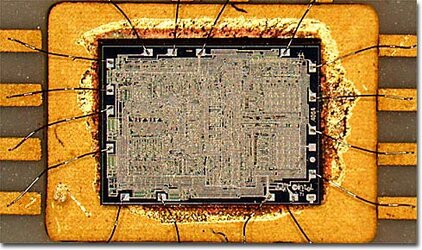- Joined
- Jul 19, 2002
- Location
- WPAFB, OH
I just though I would share this with you guys. I was playing around with some old microprocessors and microcontrollers today when I removed a label off of a Motorola MC68HC11 8-bit Microcontroller (only works with assembly codeing) and found a neat little viewing window of the chip packaging.
I dont know if any of you have taken classes in materials processing or micoprocessor, but its neat to see the actual stuff you learned in real life.
Heres the closeup, it also looks like AMD fab'd this for Motorola.



The last photo was the best of them all so I sharpened it and worked on clarifying the image.
What you see is a circular viewing window with the square silicon substrate underneath it. The star shaped lines are actually high purity aluminum that have been microsolderd onto the chip surface to contact pads. One wire for each pin of the DIP package. The white stuff underneath the square is a type of ceramic glue they use to insulate and prevent shifting.
This kind of jogged my memory on these subjects and I was wondering if you think an article on silicon chip manufacturing and how they make cpus would be enjoyed on the overclockers.com website? If you think so, Ill get to work on it.
I dont know if any of you have taken classes in materials processing or micoprocessor, but its neat to see the actual stuff you learned in real life.
Heres the closeup, it also looks like AMD fab'd this for Motorola.



The last photo was the best of them all so I sharpened it and worked on clarifying the image.
What you see is a circular viewing window with the square silicon substrate underneath it. The star shaped lines are actually high purity aluminum that have been microsolderd onto the chip surface to contact pads. One wire for each pin of the DIP package. The white stuff underneath the square is a type of ceramic glue they use to insulate and prevent shifting.
This kind of jogged my memory on these subjects and I was wondering if you think an article on silicon chip manufacturing and how they make cpus would be enjoyed on the overclockers.com website? If you think so, Ill get to work on it.

